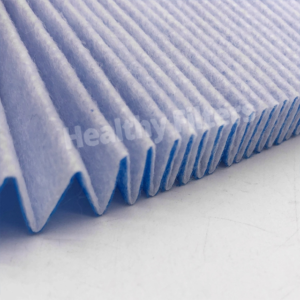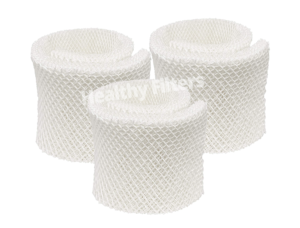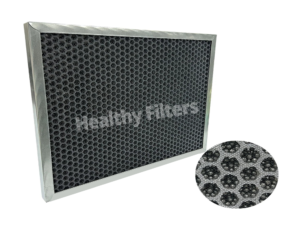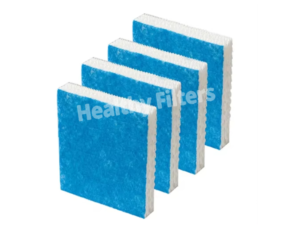Washable Panel Filter Mesh is a high-efficiency primary filter component designed for repeated use. It intercepts large particle pollutants (such as dust, hair, fiber, etc.) through a durable metal or synthetic fiber structure, and supports water washing or compressed air cleaning to restore performance. With its core advantages of economy, environmental protection and long life, it is widely used in commercial buildings, industrial workshops and high dust load environments, significantly reducing consumable costs and maintenance frequency.
Core structure and materials
Material composition
Metal mesh: It uses high-strength materials such as aluminum and 304/316 stainless steel, and is formed into regular mesh (aperture 1-5mm) through weaving or stamping processes. It is corrosion-resistant and anti-deformation, and is suitable for high temperature (≤300℃) or humid environments.
Synthetic fiber mesh: Polyester (PET) and polypropylene (PP) non-woven fabrics are treated with waterproof and oil-proof coatings, with a gram weight of 80-200g/㎡, which is both flexible and tear-resistant, and is suitable for lightweight demand scenarios.
Frame design
Reinforced frame: Aluminum or engineering plastic frame improves overall rigidity and supports embedding in standard filter slots (such as 592mm×592mm, 610mm×610mm).
Multi-layer composite: Some models use wavy or pleated structures to increase the effective filtration area and increase dust holding capacity by 30%-50%.
Core functions and advantages
Efficient interception and reuse
Can capture ≥5μm particles (such as gravel, flying insects), the filtration efficiency meets MERV 4-6 (ASHRAE 52.2) or ISO Coarse standards, and reduce the load on the back-end filter.
Supports repeated cleaning (water flushing, compressed air backwashing or ultrasonic cleaning), the number of cycles is up to 10-20 times, and the life span is up to 3-5 years.
Low pressure drop and energy saving
The open mesh structure maintains an initial pressure difference of <30Pa, reduces system energy consumption, and is suitable for high air volume (≥2000m³/h) ventilation equipment.
Environmental adaptability
Weather resistance: metal mesh can withstand temperatures ranging from -50°C to 300°C; synthetic fiber mesh can withstand weak acid, alkali and oil mist erosion (surface oil-proof treatment).
Anti-mildew and antibacterial: optional silver ion coating to inhibit microbial growth and meet medical or food workshop hygiene standards.
Economic and environmental protection
Reduce the consumption of disposable filter materials, reduce waste generation by more than 80%, and achieve a circular economy through cleaning and reuse.
Typical application scenarios
Commercial buildings: shopping malls, hotels, fresh air system entrances, intercept catkins, fallen leaves and coarse dust, protect surface coolers and high-efficiency filters.
Industrial manufacturing:
Woodworking workshops and foundries pre-filter sawdust and metal dust to extend the life of bag filters.
Food processing lines intercept debris and hair to meet HACCP certification requirements.
Catering industry: front end of kitchen exhaust system, capture oil mist and large particle residues, support frequent cleaning.
Transportation: subway tunnel ventilation shafts to prevent garbage and paper scraps from clogging the fan.
Selection and Maintenance Guide
Selection Key Parameters
Contaminant Type:
Metal Dust/High Temperature Environment: Stainless Steel Perforated Mesh (Aperture 2-3mm) is Preferred.
Oil Mist/Wet Scenarios: Choose Oil-Proof Coated Polyester Mesh (Weight ≥150g/㎡).
Air Volume Adaptation: Select mesh density (opening rate 30%-60%) and size according to system air volume to avoid excessive pressure difference.
Cleaning and Maintenance
Cleaning Cycle: Through pressure difference monitoring or visual inspection (recommended once a month), cleaning is required when the pressure difference is >2 times the initial value.
Cleaning Method:
Metal Mesh: Soak in neutral detergent and rinse with a soft brush, or back-blow with compressed air (0.3-0.5MPa).
Synthetic Fiber Mesh: Rinse with low-pressure water (avoid high pressure damage to the fiber), and reuse after thorough drying in a cool place.
Replacement Standard: Replace when mesh deformation rate >30%, coating peeling, or pressure difference still exceeds the standard after repeated cleaning.
The washable plate filter takes “efficient interception and circular economy” as its core value, and has become the preferred solution for reducing operating costs and practicing sustainable development in multi-stage filtration systems. It is especially suitable for harsh scenarios with high dust and high maintenance frequency, helping companies achieve the dual goals of green production and cost optimization.





